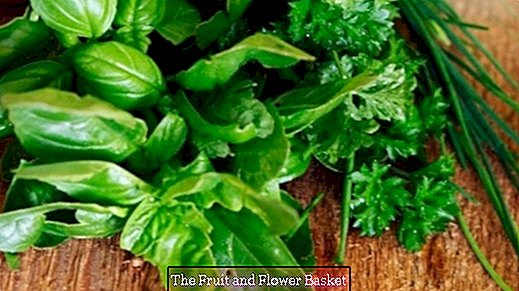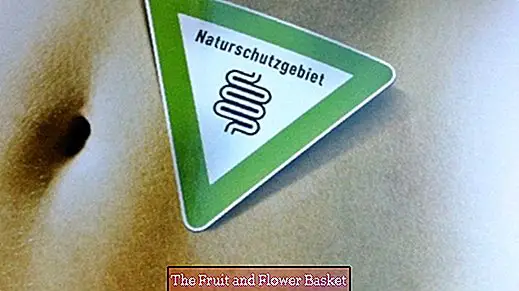Typical herbs and spices in the kitchen
These herbs and spices should not be missing in your kitchen. They are suitable for many different recipes. Which herbs should you have fresh there, which in dried form? This list of kitchen herbs gives the answer.
The following culinary herbs and spices (in addition to salt and pepper) cover in my opinion the most important:
- basil
- savory
- Chili / paprika
- clove
- garlic
- Lovage / Maggie's herb
- laurel
- marjoram
- nutmeg
- oregano
- rosemary
- sage
- chives
- vanilla
basil
Basil is used in the kitchen in the form of fresh and dried leaves. However, basil loses its aroma when dried! So ideally use fresh. For this purpose, basil can be grown in the flower pot on the windowsill in the kitchen. The plant is annual to perennial, but you have to take good care of it. How to do that is here: grow basil.
Basil is available in Germany in pot all year round. It grows on the field from June to October, otherwise it comes out of the greenhouse.
Fits the following dishes
Basil is indispensable in southern European and especially Italian cuisine. So anything that has anything to do with tomatoes is a great candidate for basil: tomato sauces, lasagna, tomato and mozzarella salad, tomato salad, etc.
savory
Savory is very popular in dried form, but it is also used fresh: Who would have thought, in bean dishes :) The often finely chopped aromatic leaves are often found in fillings, soups, omelets and salads. In old recipes, savory becomes too Saturei called.
Chili / paprika
Chili or paprika may not be missing in any kitchen today. Paprika powder, which is available in different "degrees of severity" (from "rose paprika" to "noble sweet" to "extra"), is used in many dishes if some sharpness is to be added. Coarsely ground dried spicy chilies are served wherever it is allowed to burn properly. Of course, according to taste.
But chilies are also suitable fresh or even as vegetables. When processing, however, should be taken to ensure that you then wash your hands well with soap or alcohol. Otherwise, it can lead to unpleasant "burns", if you afterwards, for example, into the eyes. Possibly. Wear plastic gloves!
If you want to reduce the sharpness, you should only use fruit bowls without placenta, seminal walls and seeds.
clove
Cloves are the buds of the clove tree. They are picked before flowering and dried. High quality cloves have a high oil content. This can be determined in two ways:
- Press with your fingernail against the stem. If the clove separates oil, it is good.
- Give the carnation in water: If it floats above or swim at least vertically with the head up, the oil content is high enough.
Cloves are very healthy because they have a very high level of antioxidants. They stop the oxidation of fat and thus offer added health benefits. Anyone who has ever bitten on a clove, knows that they taste very intense. Carefully dosed but they refine many dishes: marinades, sauces, sausages, meat and fish dishes, but also gingerbread.
What not everyone knows: They are often part of curry powder.
Please only eat the carnation, it tastes good. The stem is extremely bitter.
If you use cloves in funds, soups or punch, you take out the cloves at the end of the cooking time again. And they fit into Christmas cookies and curries.
garlic
One of my favorite ingredients in my kitchen! Garlic tastes good with everything - ok, maybe not with vanilla ice cream. No wonder, garlic is pretty much part of the kitchen in every culture and region. Ideally, the garlic cloves are minced and steamed. But even in casseroles and soups, you can simply bake the cutted toes or cook with it. Some advise against using a garlic press.
Peeling garlic is always a bit tedious. It is easier if you press with the flat side of the knife on the toe, until it cracks. Then the shell can be easily removed.
Only downside of garlic: The smell behind does not like everyone else :) The smell of garlic can be reduced by drinking milk or chewing parsley. However, you can never completely remove the odor, as it is also secreted via the skin. Best remedy: The garlic should be as fresh as possible!
Lovage / Maggie's herb
Lovage is also called maggie herb, since the two are very similar in taste. Maggi wort, however, contains no lovage. Although lovage grows best in warmer areas, so you can grow it here in Germany in vegetable and herb gardens.
Fresh lovage leaves fit into soups, egg dishes and mushroom dishes.The taste of lovage is reminiscent of celery, but is a bit sharper and more bitter. If you chop the leaves, you can season soups, salads, obatzters and stews with them.
Dried used the seeds, which also fit into stews, but also to roast.
laurel
Often dried bay leaves are used. Soups, stews (such as lentil stew), meat dishes but also fish are flavored with it. But also to insert cucumbers, herring and for brawn you can use bay leaves. When eating you remove the leaves then again.
marjoram
Marjoram can be used fresh or dried, with the plant being one-year-old and perennial. Here in Germany annual plants are more aromatic, perennials less. Marjoram is very spicy and contains a lot of essential oil. If you grow marjoram yourself, it is best harvested before the flowering season, which runs from June to September. The location should be sunny.
The fresh or dried leaves you can use for seasoning potato dishes, soups, sauces, sausages and legumes.
nutmeg
Gourmets have whole nutmegs in the kitchen to grate them fresh in dishes. Because the taste evaporates otherwise happy. Nutmeg is a real all-rounder: It goes well with potatoes, soups and stews, but also with pastries. Also in meatballs and roast pork nutmeg is doing very well! Another application is vegetables: spinach, cauliflower, Brussels sprouts, kohlrabi, red cabbage, peas, carrots, parsnips. Nutmeg is also very good in milk, cheese and cream sauces.
It is generally known that nutmeg can be intoxicating. But only in a very high dose. Before you get hallucinations, you have to vomit before :) Did not enforce on the drug market :)
oregano
Oregano, also wild marjoram, has only been used in the kitchen for 300 to 400 years. Oregano is used mainly in Italian (and Spanish) dishes: pizza, omelets, Italian sauces, tomato dishes, vegetable casseroles and lamb are the classics for oregano.
rosemary
Rosemary thrives best in warmer, dry climates, here in Germany he does not make it over the winter. It's best to geernet the branches, not the individual needles. But also dried rosemary is delicious.
Especially in the Mediterranean cuisine rosemary plays an important role as a spice. It is part of the Provence herbal mixture. Rosemary is a classic grilling: meat, poultry, lamb, zucchini, potatoes ("rosemary potatoes") - grilled with rosemary very delicious. Also in the herb butter he fits.
But even if it should be sweet, rosemary goes well: rosemary honey tastes delicious and apple jelly can be super flavored with rosemary.
sage
Sage also tastes very good dried, but also grows well in the herb garden. Unfortunately, he is not winter proof because he comes from Mediterranean areas.
Seasoned with sage is especially poultry and poultry fillings. But also other meat dishes, game and sausage are flavored with it. Sage makes fat food easier to digest.
chives
Chives belong in every herb garden or on every kitchen window sill, as it has dried too little aroma. He is persistent and easy to cultivate. Therefore, it is best to use fresh or freeze-dried. Only the above-ground tube leaves are used, which are finely cut. Then off with salads, soups, egg dishes, quark dishes or mayonnaise.
In Austria and Bavaria you like to eat chive bread (sandwich with a lot of chives), and in Frankfurt and Kassel it belongs in the green sauce.
vanilla
Vanilla pods are of course best used in sweets and desserts: chocolate, cocoa, ice cream, puddings, creams, baked goods.
If you like something a bit fancier, you can use vanilla to spice up white meat or fish (lobster, salmon).
In Europe, the Bourbon vanilla pod is used the most. It comes from Africa and has a very intense aroma. A good vanilla pod can be recognized by the fact that it is elastic and leathery. In no case may she be hard and dry! The pods exude vanillin crystals: a quality trait that is sometimes tried to mimic by spraying synthetic crystals. You can tell by the fact that the crystals are evenly distributed throughout the pod. Of course, natural crystals are distributed unevenly.
Vanilla products
From vanilla vanilla extract and vanilla powder is produced.
vanilla extract is a liquid extract of vanilla and about 35% of ethanol. Sometimes sugar syrup is also present. Pure vanilla extract is characterized as such from real vanilla pods, is highly concentrated and virtually unlimited shelf life.
vanilla powder are the ground seeds of vanilla and can be used alternatively to vanilla pods. Unfortunately, the vanilla flavor flutes in the manufacturing process. The vanilla powder is therefore only used to create the typical black dots.
Then dear ground vanilla use, because there the capsule sleeves are mitgemahlen: much more aromatic than vanilla powder from seeds.
vanillin
Vanillin is contained in vanilla rods and can be produced relatively cheaply biotechnologically. Real vanilla contains at least 50 other flavorings and more than 130 chemical compounds. All the components that make up the typical vanilla flavor. Ergo: Vanilla flavor is not a full substitute for vanilla.
Is vanilla yellow?
A common misconception is the assumption that vanilla is yellow. However, the color is often due to artificially added food dyes (i.d.R. Carotenes). A classic vanilla dish is therefore often only yellow because it contains a lot of chicken eggs. The vanilla has nothing to do with the yellow color.
Closing remarks
This, of course, is not an exhaustive list, but my personal list of spices and herbs that I often use. The list should be understood as a suggestion, further experiences and spices you can very happy in the comments discuss!
I've heard a lot about cardamom but have never used it before. Here is a great tip.





